K. Lee Lerner's Blog
June 23, 2023
Russia: Wagner Group insurrection (updated)
 Prigozhin’s units are grounded and in Russia’s prison culture, where “brutally imposed caste systems govern life and death” and where society is dives into blatniye (thieves), muzhiki (men), kozliy (billy goats), and petukhi (roosters).Highly recommended reading: Kristaps Andrejsons. “Russia’s Convict-Soldiers Have Their Own Brutal Rules.” Foreign Policy. May 16, 2023.P.S. Americans: This is what an “armed insurrection” actually looks like. The Wagner Group won’t be leaving at curfew.======Updates:Russia tightens security in and around Moscow. All mass outdoor events scheduled before 1 July are cancelled. The mayor of Moscow warns residents not to travel. In a televised address to the nation, Putin characterized Prigozhin’s actions as a “betrayal” and “treason” and promised to punish rebels.=====24 June 2023=====According to Russian TV channel Rossiya 24, after his public statements Putin can’t easily deal directly with Prigozhin and so Belarusian leader Alexander Lukashenko is serving as a bridge of communication and has helped convince Prigozhin to at least temporarily stand down.=====The BBC reports Prigozhin has instructed his forces to abandon their march on Moscow to “avoid bloodshed” and to return to their bases.=====Prigozhin denies attempting a coup aimed at the political leadership (Putin) but rather that is focus is on rebellion against and a call for changes in Russian military leadership (and rescinding an unconfirmed Russian MoD move to absorb Wagner minus Prigozhin). Russian state media report Prigozhin will go to Belarus.=====There are multiple reports that Wagner forces are moving out of Rostov-on-Don leaving and seized military facilities in Voronezh=====Dmitry Peskov, President Putin’s press secretary, says Wagner mercenaries can sign a Ministry of Defense contract and fighters who took part in the uprising will not be prosecuted.===(KLL Comment: This essentially puts Wagner forces (or former Wagner forces) inside the formal Russian military structure yet still allows Wagner to exist an an independent entity. A short term solution with long term danger. If, as it appears, Prigozhin will keep his neck, then he gains influence with the Russian MoD (or he may have negotiated leadership changes within the Russian MoD) and this solution may keep Wagner a separate entity (note: Wagner also operates in Africa). If I were Ukraine, I would not want Prigozhin active in Belarus.)=====Given the chaotic and unclear nature of the information coming out of Russia — especially with regard to whether Wagner will be absorbed into the MoD or allowed to continue as an independent force — it is hard to make any high confidence assessments.=====As Wagner pulls back, the question becomes “What is Putin’s next move?” If he compromised with Prigozhin, how does Putin reassert legitimacy and authority among his own loyalists. What steps does he take to prevent further attempts to undermine his authority. Doe he dramatically escalate attacks on Ukraine to avert attention, show strength, etc.?
Prigozhin’s units are grounded and in Russia’s prison culture, where “brutally imposed caste systems govern life and death” and where society is dives into blatniye (thieves), muzhiki (men), kozliy (billy goats), and petukhi (roosters).Highly recommended reading: Kristaps Andrejsons. “Russia’s Convict-Soldiers Have Their Own Brutal Rules.” Foreign Policy. May 16, 2023.P.S. Americans: This is what an “armed insurrection” actually looks like. The Wagner Group won’t be leaving at curfew.======Updates:Russia tightens security in and around Moscow. All mass outdoor events scheduled before 1 July are cancelled. The mayor of Moscow warns residents not to travel. In a televised address to the nation, Putin characterized Prigozhin’s actions as a “betrayal” and “treason” and promised to punish rebels.=====24 June 2023=====According to Russian TV channel Rossiya 24, after his public statements Putin can’t easily deal directly with Prigozhin and so Belarusian leader Alexander Lukashenko is serving as a bridge of communication and has helped convince Prigozhin to at least temporarily stand down.=====The BBC reports Prigozhin has instructed his forces to abandon their march on Moscow to “avoid bloodshed” and to return to their bases.=====Prigozhin denies attempting a coup aimed at the political leadership (Putin) but rather that is focus is on rebellion against and a call for changes in Russian military leadership (and rescinding an unconfirmed Russian MoD move to absorb Wagner minus Prigozhin). Russian state media report Prigozhin will go to Belarus.=====There are multiple reports that Wagner forces are moving out of Rostov-on-Don leaving and seized military facilities in Voronezh=====Dmitry Peskov, President Putin’s press secretary, says Wagner mercenaries can sign a Ministry of Defense contract and fighters who took part in the uprising will not be prosecuted.===(KLL Comment: This essentially puts Wagner forces (or former Wagner forces) inside the formal Russian military structure yet still allows Wagner to exist an an independent entity. A short term solution with long term danger. If, as it appears, Prigozhin will keep his neck, then he gains influence with the Russian MoD (or he may have negotiated leadership changes within the Russian MoD) and this solution may keep Wagner a separate entity (note: Wagner also operates in Africa). If I were Ukraine, I would not want Prigozhin active in Belarus.)=====Given the chaotic and unclear nature of the information coming out of Russia — especially with regard to whether Wagner will be absorbed into the MoD or allowed to continue as an independent force — it is hard to make any high confidence assessments.=====As Wagner pulls back, the question becomes “What is Putin’s next move?” If he compromised with Prigozhin, how does Putin reassert legitimacy and authority among his own loyalists. What steps does he take to prevent further attempts to undermine his authority. Doe he dramatically escalate attacks on Ukraine to avert attention, show strength, etc.?
Russia and Ukraine edge toward a radiologic abyss
 With such cautions noted, President Zelenskyy yesterday warned via Twitter that “We have just had a report from our intelligence and the Security Service of
With such cautions noted, President Zelenskyy yesterday warned via Twitter that “We have just had a report from our intelligence and the Security Service of  . Intelligence has received information that Russia is considering a scenario of a terrorist attack on the Zaporizhzhia nuclear power plant. A terrorist attack with radiation leakage. They have prepared everything for this…”As President Zelenskyy aptly went on to aptly note, radiologic contamination observes no international borders.Not all nuclear contamination and/or leaks, however, must be explosively Chernobyl-like with broad atmospheric dispersion. Parties with the intent of committing nuclear terrorism can also create damage that disables nuclear power plants and primarily contaminates surrounding soils and water tables. Such sabotage could also prove debilitating to military operations in the region.It is also important to note that while the Russian have occupied and controlled the Zaporizhzhia nuclear power plant (the largest in Europe), there are other nuclear power plant targets of opportunity in Western Ukraine.The Zaporizhzhia nuclear power plant has six reactors. the breach of the Nova Kakhovka dam downstream from the facility in May lowered reservoir levels of water used to cool the plant, but experts predict the facility retains months of cooling water reservesIn the west, the Khmelnytskyi nuclear power plant has two existing operating reactors with two unfueled reactors under construction. In November 2022, it was knocked off the grid following missile strike sin the region. Rivne nuclear power plant has four operating reactors. South Ukraine nuclear power plant has three reactor and has three times since the Russian invasion sustained damage. It was twice disconnected from the grid in 2022 following nearby shelling and missile strikes.After its invasion of Ukraine in February 2022, Russian forces occupied the damaged Chernobyl nuclear power plant and externalpower supplied to the plant was disrupted. Ukraine claims the site’s analytical laboratories for radiation monitoring were destroyed and analytical instruments were stolen before Russian forces transferred control of Chernobyl back to Ukrainian personnel at the end of March 2022. At Chernobyl, Unit 1 is still in the decommissioning process. Units 2 and 3 were respectively closed in March 1999 and December 2000. The Unit 4, reactor that exploded in 1986 is protected by the sarcophagus built over the reactor following the accident and the New Safe Confinement dome moved over the sarcophagus in 2016 into position in 2016. Units 5 and 6 at Chernobyl were never finished.Chernobyl also houses the Central Spent Fuel Storage Facility (CSFSF), a dry storage site for used nuclear fuel assemblies from the reactors at Khmelnytskyi, Rivne and South Ukraine nuclear power plants.The Kharkov Institute of Physics and Technology housed an experimental nuclear reactor used for research that was shut down (placed in a deep subcritical state) immediately following the Russian invasion. The facility was used to produce radioactive isotopes for medical and industrial use was heavily damaged by shelling during fighting around the plant, but no radiotin leaks have, as of 23 June 2023 have been detected.In February 2022 news reports that the State Interregional Specialized Plants for Radioactive Waste Management (SISP) of UkrDO Radon in Kyiv was damaged by a missile proved unwarranted. The SISPs are used to store used to store radioactively contaminated materials used in industry, medicine and scientific research. No radiation leaks have subsequently been detected.Nuclear power stations at Chyhyryn, and in Odessa and Russian-annexed Crimea were never made operational.The electricity grid of Ukraine was successfully synchronized with the Continental European Grid in March 2022.Photo: Twitter Screenshot (c) K. Lee Lerner / LMG
. Intelligence has received information that Russia is considering a scenario of a terrorist attack on the Zaporizhzhia nuclear power plant. A terrorist attack with radiation leakage. They have prepared everything for this…”As President Zelenskyy aptly went on to aptly note, radiologic contamination observes no international borders.Not all nuclear contamination and/or leaks, however, must be explosively Chernobyl-like with broad atmospheric dispersion. Parties with the intent of committing nuclear terrorism can also create damage that disables nuclear power plants and primarily contaminates surrounding soils and water tables. Such sabotage could also prove debilitating to military operations in the region.It is also important to note that while the Russian have occupied and controlled the Zaporizhzhia nuclear power plant (the largest in Europe), there are other nuclear power plant targets of opportunity in Western Ukraine.The Zaporizhzhia nuclear power plant has six reactors. the breach of the Nova Kakhovka dam downstream from the facility in May lowered reservoir levels of water used to cool the plant, but experts predict the facility retains months of cooling water reservesIn the west, the Khmelnytskyi nuclear power plant has two existing operating reactors with two unfueled reactors under construction. In November 2022, it was knocked off the grid following missile strike sin the region. Rivne nuclear power plant has four operating reactors. South Ukraine nuclear power plant has three reactor and has three times since the Russian invasion sustained damage. It was twice disconnected from the grid in 2022 following nearby shelling and missile strikes.After its invasion of Ukraine in February 2022, Russian forces occupied the damaged Chernobyl nuclear power plant and externalpower supplied to the plant was disrupted. Ukraine claims the site’s analytical laboratories for radiation monitoring were destroyed and analytical instruments were stolen before Russian forces transferred control of Chernobyl back to Ukrainian personnel at the end of March 2022. At Chernobyl, Unit 1 is still in the decommissioning process. Units 2 and 3 were respectively closed in March 1999 and December 2000. The Unit 4, reactor that exploded in 1986 is protected by the sarcophagus built over the reactor following the accident and the New Safe Confinement dome moved over the sarcophagus in 2016 into position in 2016. Units 5 and 6 at Chernobyl were never finished.Chernobyl also houses the Central Spent Fuel Storage Facility (CSFSF), a dry storage site for used nuclear fuel assemblies from the reactors at Khmelnytskyi, Rivne and South Ukraine nuclear power plants.The Kharkov Institute of Physics and Technology housed an experimental nuclear reactor used for research that was shut down (placed in a deep subcritical state) immediately following the Russian invasion. The facility was used to produce radioactive isotopes for medical and industrial use was heavily damaged by shelling during fighting around the plant, but no radiotin leaks have, as of 23 June 2023 have been detected.In February 2022 news reports that the State Interregional Specialized Plants for Radioactive Waste Management (SISP) of UkrDO Radon in Kyiv was damaged by a missile proved unwarranted. The SISPs are used to store used to store radioactively contaminated materials used in industry, medicine and scientific research. No radiation leaks have subsequently been detected.Nuclear power stations at Chyhyryn, and in Odessa and Russian-annexed Crimea were never made operational.The electricity grid of Ukraine was successfully synchronized with the Continental European Grid in March 2022.Photo: Twitter Screenshot (c) K. Lee Lerner / LMG
June 17, 2023
Wave-particle duality
Of all my lectures on physics, my favorite to deliver is on wave-particle duality. The Q/A is always fun.
You can tell by the comments below the articles linked below that people have trouble wrapping their head around the concept of duality. That is understandable, especially for people who have not studied quantum physics. The misunderstandings they hold primarily arise from the human need to impose understandable answers and concepts on phenomena that we do not fully understand.
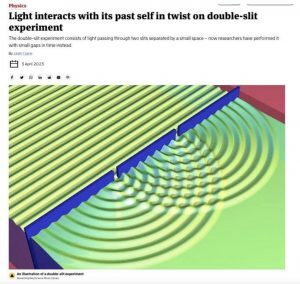
https://www.newscientist.com/article/236…
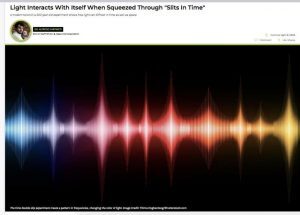
https://www.iflscience.com/light-interac…
I can tell by the comments below the article (linked in comments) that people have trouble wrapping their head around the concept of duality. That is understandable, especially for people who have not studied quantum physics.
We are often limited by how our brains are neurologically hard-wired in trying to understand. The imposition of constellations on the night sky are ancient testament to this need.
Math helps a bit. Using probability theory, and allowing for a wave-particle duality, quantum mechanics replaced classical mechanics as the method by which to describe interactions between subatomic particles. Quantum mechanics, for example, replaced the electron orbitals of classical atomic models with allowable values for angular momentum (angular velocity multiplied by mass) and depicted the position of electrons in terms of probability clouds and regions.
Both particle and wave treatments of nature have their uses.
By extending the well-known wave properties of light to include a treatment of light as a stream of photons (i.e., treating them a particles), Einstein was able to explain the photoelectric effect.
On the other hand, De Broglie showed that the electron was not merely a particle but also a wave form. This proposal led Schroödinger to publish his wave equation that described electrons as “standing waves” surrounding the nucleus.
Born and Dirac made further advances in characterizing subatomic particles (principally the electron) as waves rather than just particles and in so doing reconciled portions of quantum theory with relativity theory. It was left to Heisenberg, however, using matrix mathematics to formulate the first complete and self-consistent theory of quantum mechanics.
In 1926, Heisenberg put forward his uncertainty principle that states that two complementary properties of a system, such as position and momentum, can never both be known exactly. This proposition helped cement the dual nature of particles (e.g., light can be described as having both wave and a particle characteristics).
When misapplied to larger systems –as in the famous paradox of Schrodinger’s cat — quantum mechanics was often be misinterpreted to make bizarre predictions (i.e., a cat that is simultaneously dead and alive). On the other hand, quantum mechanics made possible important advances in cosmological theory by accepting the duality of light, electrons, and other particles.
It is, however, human limitations that make think in terms of duality, per se. Simply put, our brains are hard-wired by evolution to impose the concepts of particle or wave upon the photon or electron in order to describe them and treat them mathematically. All of this is fine, in our everyday position between the relativistic and quantum worlds, such hard-wiring give us good answers.
Yet it is misleading to think of photons and electrons, for example, as being able to be EITHER wave or particle. They ARE — integrally and simultaneously — BOTH waves and particles.
Yes, via experimental design, we can force photons or electrons to act either as waves or particles, but they are what they are — it is just that we have no concepts, words, or mathematics for what they actually are and so we must use the concepts of particles and waves to define them, measure them, and predict their behavior.
One of the most important attributes of good science — and of good scientists — is the ability to look beyond “common sense” or intuitive answers, for the results of such comfortable thinking often proves too simplistic or errant. Moreover, in our attempt to understand nature, we must also remain mindful of our own cognitive limitations and bias.
Just as some animals see different portions of the electromagnetic spectrum, the cosmos often contains phenomena like wave-particle duality that lies beyond our everyday experience and conceptual ability to characterize without mathematics or experimental models. Phenomena like wave-particle duality force us to accept nature as she reveals herself to us via observation and experiment.
Read more
https://scholar.harvard.edu/kleelerner/p…
May 22, 2023
Recommended reading and veritas incommodum on nuclear power and the harm done by “activists.”
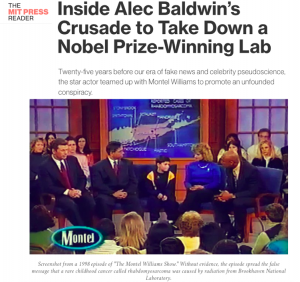 Movies like the China Syndrome, and the actions of activists — ranging from those with well-intended environmental concerns to howling lunatics — created a milieu of unfounded fear and prejudice that retarded use of nuclear fuels.Corporations that treated nuclear power development the same as other commercial projects (with attitude toward cost cutting and minimal compliance to safety standards) also degraded public trust.There is no solution to minimizing human contributions to global warming and climate change that does not involve a robust reliance on nuclear power. That is a fact well- grounded in science and engineering.Until we have serious discussions about building an energy infrastructure primarily dependent on nuclear power — along with dedicated efforts toward solving the safety problems and engineering challenges related thereto — there are no reasonably workable solutions to the environmental perils future generations face.If you don’t accept that fact, you are not a person who accepts science and evidence as the basis of making policy.If you don’t accept that fact, for all your best intentions you are either a believer in or seller of something that uses the perils of global warming and climate change as a cover or means to another end.Further reading:
Movies like the China Syndrome, and the actions of activists — ranging from those with well-intended environmental concerns to howling lunatics — created a milieu of unfounded fear and prejudice that retarded use of nuclear fuels.Corporations that treated nuclear power development the same as other commercial projects (with attitude toward cost cutting and minimal compliance to safety standards) also degraded public trust.There is no solution to minimizing human contributions to global warming and climate change that does not involve a robust reliance on nuclear power. That is a fact well- grounded in science and engineering.Until we have serious discussions about building an energy infrastructure primarily dependent on nuclear power — along with dedicated efforts toward solving the safety problems and engineering challenges related thereto — there are no reasonably workable solutions to the environmental perils future generations face.If you don’t accept that fact, you are not a person who accepts science and evidence as the basis of making policy.If you don’t accept that fact, for all your best intentions you are either a believer in or seller of something that uses the perils of global warming and climate change as a cover or means to another end.Further reading:
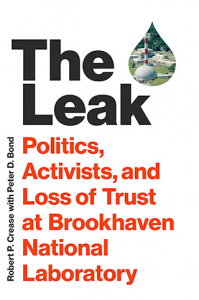
May 14, 2023
Layers of History
What do these three things have in common? He archeological site at Glanum in Provence, Van Gogh’s, ‘Fountain in the Garden of Hospital,’ and his ‘Olive Trees with the Alpilles in the Background.’ (see paintings below in comments)
Troubled with mental illness that resulted in the self-mutilation of his ear, in 1889 van Gogh voluntarily committed himself to the Saint-Paul-de-Mausole monastery-run asylum located just south of Saint-Rémy-de-Provence.
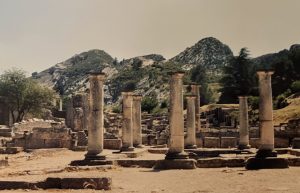
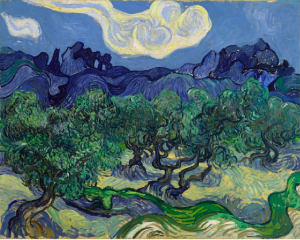

While a patient, van Gogh was free to paint in the many olive groves, cypress tree stands, and wheat fields surrounding the asylum. His paintings and landscapes of that region, including the Alpilles mountains, are now among his most well-known works.
Shortly after leaving Saint-Rémy on the road south to Les Baux, a left-hand turn leads 300 feet to Mausole compound, while on the right, just another 100 feet or so along the road to Les Baux, are the unprotected Les Antiques ruins at Glanum.
Although scattered Roman remains were discovered in the area as early as the 17th century, discovery of Les Antiques awaited the extensive excavations conducted by Jules Formigé from 1900 to 1924, well after the time van Gogh painted the area’s landscapes.
Glanum, first conquered by the Romans in 121 BC, was built upon settlements of the Celto-Ligurian people that date to the 6th century BCE. After being sacked in 260 AD by the Germanic Alemanni tribe, archeological evidence shows that Glanum was inhabited until the 6th century when it was abandoned. Les Antiques consists of an arch dating to the second century AD built to honor Caesar’s triumph over the Gauls at the decisive Battle of Alesia in 52 BC and the Mausoleum of the Juli dating to 40 BC.
Nearby there is also an expansive Roman forum (shown below) typical of the period. Archeologists have uncovered the Cryptoporticus, a subterranean passage dating to the 1st century BC as well as a spring dating to the scared Celtic-Ligurian era that the Romans also thought had healing powers.
Much of the Glanum site remains to be excavated.
It’s less than 500 feet from Glanum to the location of the van Gogh’s asylum and records from the era indicate that, during the era van Gogh painted, olive orchards were located over what is now the Glanum site. Moreover, the view from Les Antiques is similar to that in his masterpiece, ‘Olive Trees with the Alpilles in the Background.’
About 200 feet north of the Mausole monastery is the famous fountain that was the subject of van Gogh’s ‘Fountain in the Garden of Hospital and thus, given the proximity, it is quite possible (the French Ministry of Culture says “likely”) that the olive orchard used to inspire ‘Olive Trees with the Alpilles in the Background’ was, unknown to van Gogh, located over Les Antiques and other Glanum ruins.
Photo: Glanum archeological site. 2000. (c) K. Lee Lerner / LMG. All commercial rights reserved. Van Gogh prints courtesy MOMA, New York.
May 10, 2023
The baton is passed: The shame-stick of anti-science has changed hands
8 May, 2023
Highly recommended and, if you care about science, essential reading: ‘A Paper That Says Science Should Be Impartial Was Rejected by Major Journals. You Can’t Make This Up,’ by Pamela Paul, published in The New York Times (link below and in comments).
Anti-intellectual, anti-liberal, and anti-science movements shift about over time with regard to who holds the shame-stick. In the U.S., that baton is now firmly in the hands of the progressivista Leftists who have gained an outsize influence in the Democratic party.
 Science is inherently able to withstand and eventually overcome the arguments of those who allow partisan or trendy ideology to supersede evidence, but they can do substantial damage that crosses generations.
Science is inherently able to withstand and eventually overcome the arguments of those who allow partisan or trendy ideology to supersede evidence, but they can do substantial damage that crosses generations.
The recent assaults on science–as opposed to science practice–as fundamentally racist and/or in need of decolonizing are fundamentally neo-racist and neo-religious in their worldview, and so allowing them to control science policy and publishing is akin to allowing the Spanish Inquisition to be in charge of science policy and publishing.
It’s very frustrating. As someone who has spent a good part of his life trying to encourage women and empower the marginalized to study science, I’m ready to round up these folks and ship them off to science re-education camps, leaving the helicopter door open for more than a few.
Their broad-brush characterizations of science (often based on history and ideas long rejected) do nothing to promote meritocracy in the sciences or to equip and enable those from previously marginalized groups to participate in the glorious adventure of science.
The paper underlying Paul’s opinion piece has some weaknesses (e.g., it editorializes, is too long, buries and muddles some data and examples, etc.), but it is hard to believe it was rejected rather than being subject to additional editorial refinement. This is especially perplexing given the importance of the paper’s content.
If you think I am alone in my views on this issue or on the perils facing science from ideological extremists, I invite you to read the comments on The Times. Suffice it to say that the NYT readership is not known for its warm welcoming of opinions that challenge Leftist orthodoxy, yet the comments resoundingly (18 of the top 20) echo Ms. Paul’s observations and fears.
Pamela Paul. ‘A Paper That Says Science Should Be Impartial Was Rejected by Major Journals. You Can’t Make This Up.’ https://www.nytimes.com/2023/05/04/opinion/science-evidence-merits.html
The underlying paper, ‘In Defense of Merit in Science’ can be found at: https://journalofcontroversialideas.org/article/3/1/236?fbclid=IwAR0i0oMX6SW7fmWI1ADcAEpztHSLXlk-a7rEKLen-l30Q_hvl6mNgVRPdKs
April 28, 2023
Rosalind Franklin’s contributions to the discovery of DNA’s structure revised
Highly Recommended Reading: What Rosalind Franklin truly contributed to the discovery of DNA’s structure. Nature. April, 2023. (see links to all articles mentioned herein in the comments section below)
Rosalind Franklin deserves more credit for her role as a collaborator in the discovery of the structure of DNA and her other profound and foundational contributions to molecular biology, but she wasn’t the victim many have asserted, nor were the Nobel winners James Watson, Francis Crick, and Maurice Wilkens the sexist intellectual property thieves some have asserted over the years.
Rosalind Franklin deserves much more credit than she has formally received for her integral contributions to the revolutionary discovery of the structure of DNA in the 1950s. Moreover, her broader contributions to molecular biology place her in any pantheon of science or scientists.
As revealed in a paper published this month in Nature, however, recent reviews of Franklin’s notes provide persuasive evidence that prior contentions that James Watson and Francis Crick “stole” her work, or that she had the both the structure and molecular mechanism of DNA worked out before Watson and Crick published their model are false.
Watson and Francis Crick’s seminal paper detailing the discovery of the DNA double helix, was published as part of a trio of papers (one authored by Franklin) in Nature 70 years ago this month. [1] [2] [3]
Watson and Crick’s breakthrough was the intellectual culmination of many past discoveries in molecular genetics, and included the work of Franklin. While the recent discoveries show Franklin’s uncertainties over the correct double helix structure for DNA (and her lack of work on a functional model) they also reveal how integral and essential Franklin’s work was to the articulation of the structure of DNA and the confirmation of the Watson and Crick model.
Without Franklin’s work, it is quite probable that U.S. scientist Linus Pauling would have won the race to publish the correct double helical structure of DNA. (Pauling was close, having a paper in which he proposed a triple helix structure for DNA).
For many years it has been fashionable in some circles to hold Franklin out as simply a victim of sexism. Sexism is real, of course, including sexism in science but without sufficient context, opportunities are also lost to explore the many facets of sexism that help us all recognize and mitigate its manifestations. Moreover, it masks that Franklin, who was Jewish, was also troubled by antisemitism.
The recent papers in Nature also confirm what I argued in 2015 and what I have written over the years into my own writings on the discovery of DNA
As I wrote in 2015 [4], When they published their model of DNA in Nature’s April 1953 issue (Dr. Franklin also published a paper on the structure of DNA in the same issue). Watson and Crick (who worked at Cambridge) did mention Dr. Franklin. They wrote, “We have also been stimulated by a knowledge of the general nature of the unpublished results of Dr M H F Wilkins, Dr R E Franklin and their co-workers at King’s College, London.”
Did they give her adequate credit for her contributions? To their shame, I think not, but this is a far different offense than stealing Franklin’s work. Watson and Crick went beyond the elucidation of DNA structure.
Their Nobel was awarded for “discoveries concerning the molecular structure of nucleic acids AND its significance for information transfer in living material” and it’s that last bit that was uniquely Watson and Crick’s contribution. They made the link between DNA’s structure and the molecular basis for how the genetic code works.
.
It was Wilkins who showed Franklin’s famous “photograph 51″ to Watson. With Franklin’s photo (also with help for data from a report authored by Franklin in 1952) to help guide them, Watson and Crick constructed a model also built on decades of other intermediate discoveries by other scientists. The recent work reveals that Watson seeing “photograph 51” wasn’t, however, the eureka moment Watson later claimed but rather a key piece of evidence that the model they were building was correct. In fact, it was other data from Franklin and Wilkins that proved equally crucial to confirming the Watson and Crick model, and that such data wasn’t, as suggested by some over the years, acquired surreptitiously or dishonestly. The new findings show Franklin was cooperative in sharing her data.
Between Johann Miescher’s isolation of DNA in the 1870s and the 1962 Nobel Prize shared by Watson, Crick, and Maurice Wilkins, in addition to the work of Franklin, there were many intermediate steps and contributions to the Watson and Crick model.
Working with crystallographer John Bernal, William Astbury used x-ray diffraction to determine crystalline structures and attempted to build a DNA model to see how its sugar and phosphate might fit. Erwin Chargaff at Columbia University critically determined that in DNA, the proportions of adenine (A) and thymine (T) were almost the same as those of cytosine (C) and guanine (G). Linus Pauling’s own x-ray crystallography work showed that some proteins had helical shapes.
Rosalind Franklin was also an extraordinarily gifted scientist and skilled x-ray crystallographer. She received her doctorate from Cambridge in 1945, and worked on multiple projects while with the Laboratoire Central des Services Chimique de L’Etat in Paris. In 1951, she went to King’s College, London, to study the crystalline structure of DNA with Wilkins.
While Franklin may have had a hypothesis about the double helical model of DNA structure, she could not confirm it. In fact, early in 1953 she expressed uncertainly about the double helix model.
Watson and Crick had nothing to do with Franklin ‘s rejection in early 1953 of the helical structure for DNA. Franklin’s own note show she rejected modeling the data — the very exercise that allowed Watson and Crick to make the leap from structure to mechanism of function.
Publishing in Nature in April 2023, the authors of a review of Franklin’s work argued, “Franklin did not apprehend complementary base-pairing — that A could bond only with T and C only with G, with each pair of bases forming an identical structure in the molecule. In fact, she was not working with the correct forms of the bases, so she could not have made a satisfactory model had she tried (the same was true of Watson and Crick until the very last phase of their work). Neither did she realize that her data implied that the two strands were oriented in different directions — or that the B form, found at high levels of humidity, must be the biologically functional form. (The A form is found only under laboratory conditions.) She did not have time to make these final leaps, because Watson and Crick beat her to the answer.” [5]
Ultimately and critically, it was Crick who realized, as Franklin did not, that DNA consisted of two helical chains running parallel to each other but in opposite directions. With that insight the Watson and Crock model fit. Moreover, and equally as important to their Nobel Prize citations, the model provided a biophysical basis for replication, transcription and translation that now sit at the core of modern molecular biology.
It is also important to note that while Watson and Crick may not have given Franklin sufficient credit in their April 1953 paper, less than a year later – and many years before the Nobel prize was awarded — they published a more detailed model, that openly acknowledged “the formulation of our structure would have been most unlikely, if not impossible ” without Dr. Franklin’s data and other work done at King’s College).
Franklin technically did not win the prize because, by charter, no more than three recipients can share a Nobel, and none are awarded posthumously. Like Marie Curie, Franklin’s work exposed her to high doses of radiation before its dangers were fully known and she died at age 37 of ovarian cancer in 1958, four years prior to the Nobel Prize was awarded to Watson, Crick, and Wilkens.
Over the history of science there is ample evidence that sexism — and other prejudices based on race, ethnicity, and politics — certainly conspired to deny women due consideration in science. In some cases, men have been given sole credit for significant discoveries at least partly made by women. In some extreme cases, women were written out of textbooks.
The “Matilda Effect” (denial/repression of contributions of women) is still an issue with which historians of science and modern academic tenure committees still grapple.
Scientists across a number of disciplines, for example, claim the work of other women scientists merited at least a share of a Nobel Prize, including, but not limited to, Nettie Stevens (sex determination by chromosomes); Lise Meitner (physics of nuclear fission); Chien-Shiung Wu (physics related to disproving mirror image parity in subatomic particles); Ester Lederberg (microbiology advances and bacteriophage discoveries); and Jocelyn Bell Burnell (pulsars).
If the Nobel trust or terms of the prize could be altered to award Dr. Franklin, I would strongly support that effort.
I have been studying molecular biology for close to 50 years. In all that time I have never had a professor or colleague fail to laud the importance of Franklin’s work and contributions. In fact, they were always careful to point out that Franklin’s work might have put her in the running for several Nobel Prizes. Franklin’s later work helped revealed the structure of tobacco mosaic virus and she did seminal research on the polio virus.
No serious historian of science has, however, ever argued that Franklin was MORE deserving of the Prize than Watson, Crick, or Wilkens.
In all of my own lectures, and across writing and editing in many books, I have tried to ensure that Dr. Franklin gains the credit and respect she deserves, not by denigrating the legitimate work and contributions of others, but by writing a richer and more inclusive history that more completely tells the story of the discovery of the structure of DNA and other advances in science.
When Jennifer Doudna and Emmanuelle Charpentier deservedly won the 2020 Nobel Prize in Chemistry for their pioneering work with CRISPR gene editing, a technology that has also revolutionized molecular biology. Many claimed that the exclusion of Feng Zhang from a share of the prize was in some way retribution for Franklin not receiving her fair share of acclaim for her work. Many thought Zhang’s omission was simply ugly politics and a stain on this prize
While prize awards may inequities that can’t be rectified, history does not need to be a zero-sum game. We do not need to reflexively reduce the contributions of others in order to elevate the contribution of those previously marginalized.
Where there is a will –quite literally in the case of Alfred Nobel – there is a way.
As I wrote in 2015, “Without having to bestow cash awards, it would cost the Nobel Prize committees nothing to revisit history and more fully honor women and others who were overlooked because they died or — more commonly– had contributions minimized because they were women or belonged to other marginalized groups in science. Such a move would not only partially rectify past historical wrongs, but also go a long way to providing a more comprehensive and diverse pantheon of great scientists to inspire future generations.”
Such a move would not only partially rectify past historical wrongs, but also go a long way to providing a more comprehensive and diverse pantheon of great scientists to inspire future generations.
====
[1] Watson J. D. and Crick F. H. C. “A Structure for Deoxyribose Nucleic Acid.” Nature 171, 737–738 (1953)
[2] Wilkins M. H. F., Stokes A. R. & Wilson H. R. “Molecular Structure of Deoxypentose Nucleic Acids.” Nature 171, 738–740 (1953).
[3] Franklin R. and Gosling R. G. “Molecular Configuration in Sodium Thymonucleate.” Nature 171, 740–741 (1953).
[4] K. Lee Lerner. “Rosalind Franklin deserves more credit for her role as a collaborator in the discovery of the structure of DNA, but she wasn’t the victim many assume.” Taking Bearings Harvard Blogs. October. 2015. Available at https://blogs.harvard.edu/kleelerner/rosalind-franklin/
[5] Matthew Cobb and Nathaniel Comfort. “What Rosalind Franklin truly contributed to the discovery of DNA’s structure. “Nature April 25, 2023. Available online at: https://www.nature.com/articles/d41586-023-01313-5
April 1, 2023
Florida Lawmakers Claim Museum Director Violated Florida’s ‘Don’t Say Gay’ Law
In our contemporary culture, where ideology is more important that truth, the idea that a teacher or museum director might receive criticism from both the Left and Right for displaying a well known classical work of art or accurately describing classical history or culture is all too real — and certainly not a joke.
While the facts about the statue are all true, ‘Antinous as Agathodaemon’ still resides at the Ailes Museum in Berlin, this particular story — at least for now — is my April Fools Day jest.
March 18, 2023
urricane Katrina Brings Waves of Destruction to U.S. Gulf Coast
Hurricane Katrina Brings Waves of Destruction to U.S. Gulf Coast
Hurricane Katrina Brings Waves of Destruction to U.S. Gulf Coast
Taking Bearings [Column excerpt]
K. Lee Lerner
Under mandatory evacuations, I sent Brenda and Ellie (the last child left at home) to Texas for both Hurricanes Ivan (2004) and Katrina (2005).
Ivan scored a direct hit, the eye passed right over Sibley. Katrina devastated the Mississippi coast and caused the levee breach that flooded New Orleans, but located in the northeast quadrant of Katrina, Mobile Bay and the Gulf Coast to Pensacola also suffered severe damage.
I weathered both storms at Sibley with an array of pets that could not be evacuated. Most boats not anchored out were lost. Power was out for weeks with Ivan and about a week with Katrina. Until the National Guard found its footing — resources after Katrina were justifiably concentrated on Mississippi and New Orleans — it was time to fire up the motorcycle, strap a pistol to my hip, and help out wherever needed.
During both storms, I did on air-interviews for a number of news outlets, including the BBC. A number of the photos shown here appeared on news sites as part of coverage packages, etc. It was, however, much more of a personal experience than a professional assignment (though work on several books carried on with only minimal interruptions). After the storm subsided, I went west into Mississippi with a team delivering antibiotics and other supplies.
Following Katrina, media attention focused on New Orleans — it was a story easier and cheaper to cover, and sadly also a story easier to spin and politicize. In contrast, the people of Mississippi who felt the brunt of the storm’s fury — a blow that included a 30 foot storm surge– just resolutely and quietly went about writing hundreds of good stories of bravery, endurance, self-reliance, and resilience.
Related Photos:
The first surge from Hurricane Katrina along Mobile Bay in 2005 Within three minutes, the spot from which I took the picture was under about four feet of fast moving water. 2005 ©LMG Photo by K. Lee Lerner. All rights reserved
Katrina devastated the Mississippi coast and caused the levee breach that flooded New Orleans, but located in the northeast quadrant of Katrina, Mobile Bay and the Gulf Coast to Pensacola also suffered severe damage.
I weathered both storms at Sibley with an array of pets that could not be evacuated. Most boats not anchored out were lost. Power was out for weeks with Ivan and about a week with Katrina. Until the National Guard found its footing — resources after Katrina were justifiably concentrated on Mississippi and New Orleans — it was time to fire up the motorcycle, strap a pistol to my hip, and help out wherever needed. 2005 ©LMG Photo by K. Lee Lerner. All rights reserved
I tried to get as close as possible to the incoming waves. It was important to stay mobile and so I used my motorcycle to avoid roadblocks created by fallen trees. 2005 ©LMG Photo by K. Lee Lerner. All rights reserved.
I tried to get as close as possible to the incoming waves. A spit of the bluff allowed me to wade out about thigh deep to capture this shot. That depth was short-lived and within one set of waves the water was up to my chest and a hasty retreat in order. — 2005 ©LMG Photo by K. Lee Lerner. All rights reserved
High on the bluff, Sibley suffered only downed trees, power loss, and moderate wind damage, but those below the bluff were flooded by Katrina’s storm surge.2005 ©LMG Photo by K. Lee Lerner.
Katrina brought misery in the form of downed trees, power loss, and wind damage,— K. Lee Lerner. Hurricane Katrina Brings Waves of Destruction to U.S. Gulf Coast. Taking Bearings [Column excerpt] September 2005.\
Lee Lerner’s portfolio covering science and global issues includes multiple RUSA Book and Media Awards, books named Outstanding Academic Titles, and two global circumnavigations. He serves as an advisor, editor, and contributor to respected international news and academic resources.
Photo Credits: All Photos by K Lee Lerner ©LMG All rights reserved.
Additional information and selected writings are available at scholar.harvard.edu/kleelerner and via harvard.academia.edu/kleelerner
An online journal, serving as an archival mix of professional and personal photos, is accessible via https://www.facebook.com/media/set/?s...
Profile Photo: K. Lee Lerner. Maasai Mara, Kenya. June 2012. ©LMG.
©LMG. All rights reserved.
Permission to use excerpts from this DRAFT COPY, with appropriate acknowledgments, is normally granted for academic use. Commercial use is strictly prohibited and all content is copyright restricted. All rights reserved.
©LMG. All rights reserved.
March 13, 2023
Trust, but verify: ChatGPT can be a powerful tool, but also one that leads students and researchers astray




